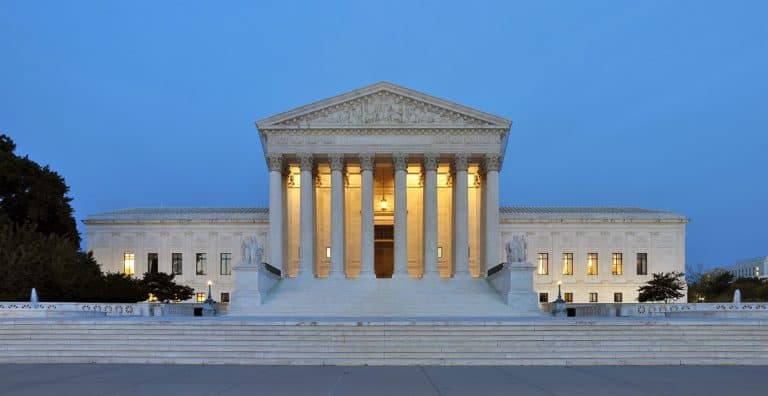
Andrew Strom is a union lawyer based in New York City. He is also an adjunct professor at Brooklyn Law School.
When the Supreme Court issued its decision in Glacier Northwest v. Intl. Bhd of Teamsters, Local No. 174 last June, Justice Ketanji Brown Jackson was the lone dissenter. The question in Glacier Northwest was whether the employer’s state court lawsuit was preempted by the National Labor Relations Act (NLRA). Justice Jackson pointed out that by the time the Court issued its decision, the National Labor Relations Board (NLRB) had already conducted a nine-day hearing addressing the same issues raised in the state court proceeding. She forcefully argued that the Court had “no business delving into this particular labor dispute at this time.” The Administrative Law Judge (ALJ) who presided over the nine-day hearing has now issued his decision, and the decision is further evidence that the Court should have listened to Justice Jackson.
In case you forgot, Glacier Northwest involved a strike by cement truck drivers. The employer alleged that nine of the striking drivers abandoned trucks full of wet concrete without telling anyone and that this raised an imminent risk of serious damage to the trucks. The employer sued the union, seeking damages for the expenses it incurred to avoid that damage. The union argued that the employer’s lawsuit was preempted by the NLRA because the strike was at least arguably protected by the Act, and as proof of that, the union pointed to a complaint issued by the NLRB’s General Counsel accusing the employer of illegally retaliating against the striking workers. The Court majority decided that it would not consider the NLRB complaint because it was issued after the state court proceedings concluded. The Court remanded the case for the state court to consider the effect of the NLRB proceedings, but not before issuing what amounts to an advisory opinion about whether the allegations in the complaint were sufficient to survive a motion to dismiss on preemption grounds.
Justice Jackson did not object to the majority’s decision to allow the state courts to have the first crack at deciding the significance of the NLRB complaint, but she faulted the majority for “intrud[ing] into this labor dispute while it is pending before the Board.” The ALJ’s decision shows why it made no sense for the Court to opine about mere allegations at a time when there had already been a nine-day hearing that created a voluminous factual record. Guess what? It turns out that allegations in the employer’s complaint differed substantially from the facts proven at trial. The judge found that the allegation that nine strikers abandoned full trucks without telling anyone was false. Instead, he found that each of the drivers informed their supervisor, the crew working with the supervisor, or the dispatch office that their trucks had full loads. Moreover, the judge found that all but one of the nine drivers left their trucks running with the drums rotating, and the remaining driver notified his supervisor of the full load. Further, some of the drivers added water to the concrete to slow its hardening. The judge found that the company could have slowed the hardening of the concrete in the trucks by adding sugar or chemical retardants, yet it did not take this step, undermining Glacier’s claim that the walkout created an emergency situation.
The ALJ made numerous additional findings that cast the dispute in a different light than the allegations before the Supreme Court. First, while the employer did not know the exact date and time of the strike in advance, it had plenty of notice that a strike was coming. Next, the drivers were aware that operating engineers, quality control technicians, laborers, and subcontracted mechanics were available to tend to the trucks. The drivers were also aware of the availability of the chemical retardants, and they knew that the concrete could be safely dumped in bunkers in the yard. And, the union instructed the drivers to notify dispatch or their supervisor of the condition of their trucks. Finally, it wasn’t as though the union directed the drivers to begin the strike only when they had full loads of concrete in their trucks – of the 53 striking drivers, only 19 had full or substantially full loads at the time the strike was called. And, half of the drivers with full loads dumped the loads themselves, further proof that the union did not set out to damage the employer’s trucks. Based on all of these findings, the ALJ found that the strike was not only arguably protected, but it was actually protected, and Glacier Northwest acted illegally when it disciplined some of the strikers.
Reading Justice Jackson’s dissent in light of the ALJ’s decision shows just how much she is entitled to say, “I told you so.” The ALJ’s ultimate conclusion makes her argument even stronger, but even if he had come out the other way, Justice Jackson was right about the need for the agency to clear up factual disputes. She noted that the bare record before the Court left unresolved whether the drivers left the drums rotating in their trucks when they returned them to the yard, and the company’s own submissions in court suggested that precautions taken by the drivers gave it adequate time to prevent harm to the trucks. She asserted that determining whether the strike was protected cried out for an evidentiary hearing where an expert agency could engage in detailed fact-finding, including the “tedious work of making contentious credibility determinations.” Justice Jackson pointed out that Congress assigned the Board the “responsibility for initially determining what happened and taking the first crack at determining whether the NLRA protects the union’s conduct.” What value was there in the Court weighing in on hypothetical facts that turned out not to be true? The Court held that the strike was not arguably protected because, based on allegations in Glacier’s complaint, the union did not take “reasonable precautions” to avoid putting the company’s trucks in harm’s way. But what constitutes reasonable precautions for cement truck drivers will necessarily differ from the kinds of reasonable precautions other types of workers would need to take, so the opinion doesn’t even provide meaningful guidance for future cases in other industries.
The Glacier Northwest majority did not purport to change the standard for determining when a state law claim is preempted by the NLRA. And neither party in the case challenged the NLRB’s long-held (though inadequately justified) rule that strikers lose the protections of the NLRA if they walk off the job without taking “reasonable precautions” to protect their employer’s property from “forseeable, aggravated and imminent danger.” So, the decision just amounted to application of settled law to the allegations made by the company. And, as Justice Jackson cautioned her colleagues, “our different takes on these allegations only underscore the potential for variable outcomes when courts apply the Board’s fact-dependent principles to bare assertions.”
Now, the detailed factual record developed at the NLRB hearing, and the ALJ’s findings based on that record, serve as a cautionary tale for state court judges who are asked to weigh in on a labor dispute within the NLRB’s jurisdiction before the agency has had an opportunity to gather the facts and apply the law.










Daily News & Commentary
Start your day with our roundup of the latest labor developments. See all
October 27
GM and Rivian announce layoffs; Boeing workers reject contract offer.
October 26
California labor unions back Proposition 50; Harvard University officials challenge a union rally; and workers at Boeing prepare to vote on the company’s fifth contract proposal.
October 24
Amazon Labor Union intervenes in NYS PERB lawsuit; a union engages in shareholder activism; and Meta lays off hundreds of risk auditing workers.
October 23
Ninth Circuit reaffirms Thryv remedies; unions oppose Elon Musk pay package; more federal workers protected from shutdown-related layoffs.
October 22
Broadway actors and producers reach a tentative labor agreement; workers at four major concert venues in Washington D.C. launch efforts to unionize; and Walmart pauses offers to job candidates requiring H-1B visas.
October 21
Some workers are exempt from Trump’s new $100,000 H1-B visa fee; Amazon driver alleges the EEOC violated mandate by dropping a disparate-impact investigation; Eighth Circuit revived bank employee’s First Amendment retaliation claims over school mask-mandate.